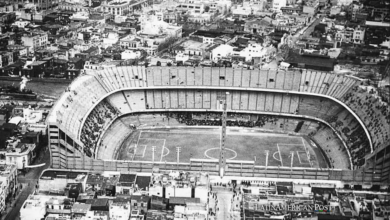European Super League: The football business model in crisis
The economic crisis of the "greats" of world football puts the business model of this industry in check .

With the announcement of the SuperLiga, the fact that these wealthy clubs were seeking to considerably increase their income came to light, which revealed part of their crisis. Photo: FCBarcelona.es
LatinAmerican Post| Luis Angel Hernández Liborio
Escucha este artículo
Leer en español: Superliga Europea: El modelo de negocio del fútbol en crisis
It has been a week with a whirlwind of news. On April 18, 12 major European clubs announced the creation of the European Super League, an elite tournament that sought to "improve the quality and attractiveness of the spectacle offered to fans," according to a statement from Barcelona FC. But the public also learned that these rich clubs sought to considerably increase their income, which revealed part of their crisis.
The Super League, the tip of the iceberg
The nascent league is on hiatus, after 10 of the 12 clubs withdrew from it. The English, the Italians and a Spansih club quitted, leaving Real Madrid and Barcelona alone. The truth is that despite the apparent failure of the project, the crisis in the football business model has become evident , how do "common" clubs expect to survive if the rich are going through a difficult financial situation?
The pretext of the elite clubs to create this alternate tournament was that the Covid-19 pandemic caused them losses and put them in a difficult financial situation, but the reality is that many of their economic problems came from long ago. In the list of the most valuable sports franchises of Forbes magazine in 2020 there are 3 of the 12 clubs that would make up the Super League: Real Madrid with a value of $ 4.24 billion, Barcelona with a value of $ 4.020 million and Manchester United with a value of $ 3.081 million. The other 7 spots are filled by NBA, NFL and MLB franchises.
Las Franquicias más caras de todo el DEPORTE actualmente
Vía @forbes #WeLoveSports #TeamMéxicoBets pic.twitter.com/ygu5scvgVI
— TEAMMEXICOBETS (@teammexicobets) March 4, 2021
At that the level of income, audience and fans, the NLF alone competes not only with the Spanish and English leagues, but also with the FIFA World Cup or the Olympic Games. In the midst of the 2020 season, NFL consultant Marc Ganis told ESPN that additional income from American football teams would allow the league to survive the pandemic in good condition. An important point that he tackled was the salary cap that in 2021 was reduced to $ 182.5 million . According to ESPN, this measure that does not exist in European football.
FIFA World Cup vs NFL Revenue. FYI. EPL di sekitar 6.4B USD pic.twitter.com/sLPCCEO1H6
— Notaslimboy (@NOTASLIMBOY) July 1, 2019
You can also read: Argentina: IMF debated interest rate revision
The salary bubble of European football
Despite the size of the NFL, NBA or MLB, their signings and salaries are often below the large numbers in European football. The Brazilian Neymar is a good example, his signing cost 222 million euros during his transfer to the French club Paris Saint-Germain, being the most expensive in history so far. In 2020, in the midst of the crisis due to the pandemic, the "greats" of European football have spared no expense to acquire players. According to information from ESPN, 8 of the 10 most expensive signings were made by teams that wanted to form the Super League, mainly Premier League teams. For example, Chelsea paid € 80 million to sign 21-year-old Kai Havertz.
In the last 5 years, the 12 Super League clubs appear among the top 25 in terms of transfer expenses. The other 13 clubs that are part of the top are all European . The three clubs that spent the most in this period were Manchester City, Juventus and Barcelona, who exceeded € 1 billion each, according to Transfermarkt data. These numbers are a "bubble" in European football, with ever-higher salaries and transfers.
???? Florentino Pérez a @elchiringuitotv:
"La UEFA es un monopolio, debería de ser más transparente. Queremos salvar el fútbol. Puedes recibir de 120M€ a 130M€ con la UEFA, sin embargo en la Superliga Europea puedes recibir más dinero". pic.twitter.com/uHbfDgtx3R
— Calcio Serie A (@SerieA_Goleador) April 19, 2021
If the entire UEFA is taken into account, revenues in 2018 were in the order of € 21 billion, according to El País. However, despite the high income, large expenses also stand out. According to an analysis carried out by Goal.com, between the 2009/10 and 2018/19 seasons, 10 of the 12 Superliga clubs were the ones that have accumulated the most expenses and that, despite being among the highest earners, have a negative balance . One of the main reasons for expenses is the salaries of its players, which are increasing more and more.
The big question then is whether the European clubs have balance in their finances or how they have borne their exorbitant expenses. The answer is simple: debt. According to the most recent report from the consulting firm KPMG Football Benchmark, cited by El Economista, Tottenham is the most indebted club in the world with € 933 million. Their crisis predates the pandemic, the construction of a € 1.4 billion stadium put them in serious trouble that even led to no signings last winter. In the top ten are Manchester United, Barcelona, Inter Milan, Juventus, Real Madrid and Atlético de Madrid, founders of the Superliga.
The problem then is not the income, but the high costs of players, their salaries and the termination clauses of contracts (Messi's for example reached € 700 million). The income received from ticket offices, sponsorships, television rights, products, etc. become insufficient in the face of rising spending by clubs, coupled with spending on infrastructure such as stadiums, which need to meet UEFA's high standards. Is it time to restructure the business model of world football? The Super League beyond failure could be a wake-up call to transform the sport, but attacking the cause, not the consequences.





